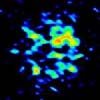| . |  |
. |
East Lansing MI (SPX) Apr 18, 2005 The beginnings of precious metals like gold can be traced to the blink of an eye in an exploding star billions of years ago, and scientists at the National Superconducting Cyclotron Laboratory (NSCL) at Michigan State University have been able to scrutinize a crucial step in that process. By reproducing the processes inside supernovas in a laboratory, scientists have resurrected an isotope of nickel � one that no longer exists in nature, but is an important link in the birth of the elements. "Every gold atom you find in the gold on your ring, every one of those atoms has gone through such a process," said Hendrik Schatz, an associate professor of physics at the NSCL. "We've now seen a link in the chain � one that controlled everything." Schatz will discuss these findings at the American Physical Society meeting in Tampa, Fla., Sunday. The isotope � nickel-78, or Ni-78 � shows up with the standard number of 28 protons, but with 50 neutrons. Because nickel must get rid of so many extra neutrons, this isotope is extremely unstable and does not exist in nature. But, Schatz explained, it did exist briefly in the chain of events that evolved into the elements. A collaboration of scientists from the United States and Germany at the NSCL recreated Ni-78 by whirling around a stable isotope of krypton gas until it reached high speeds and then firing it into a plate of beryllium metal. Because the NSCL is the nation's premier rare isotope accelerator, it's capable of shooting 100 billion krypton atoms a second. Even then, Ni-78 only shows up about twice a day. It would take less powerful accelerators years to run this sort of an experiment, Schatz explained. Ni-78 only exists for 110 milliseconds � that's a 10th of a second. Researchers at MSU haven't been the first to find Ni-78, but they've produced 11 occurrences of the isotopes, enough to finally derive its life span, said Paul Hosmer, a doctoral candidate working on the project. That's always been a missing piece of the puzzle, since the progressive decay of isotopes results in the synthesis of precious metals in exploding stars. Ni-78 has been found to be considerably quicker to decay � up to three times quicker. That changes the way scientists construct models of how elements were built before the Earth was formed some 4.5 billion years ago. Unlocking the secrets of Ni-78 is especially exciting to scientists because of a design quirk. Ni-78 is what researchers call "doubly magic." That means that its number of protons and number of neutrons are in a subatomically tidy package that makes it easier to study. Hosmer said it's like studying a bunch of cats and dogs. The groups are a lot easier to keep track of if they're in a pen. That, basically, is what being doubly magic is � an isotope with the protons and neutrons in defined pens. The 28 protons and 50 neutrons are more stable and less reactive when they're penned up. Related Links NSCL SpaceDaily Search SpaceDaily Subscribe To SpaceDaily Express
 Los Alamos NM (SPX) Apr 18, 2005
Los Alamos NM (SPX) Apr 18, 2005A University of California scientist at Los Alamos National Laboratory working with astronomers from around the world recently validated a computer model that predicts the rebirth and stellar burning and mixing processes of evolved stars. |
|
| The content herein, unless otherwise known to be public domain, are Copyright 1995-2006 - SpaceDaily.AFP and UPI Wire Stories are copyright Agence France-Presse and United Press International. ESA PortalReports are copyright European Space Agency. All NASA sourced material is public domain. Additionalcopyrights may apply in whole or part to other bona fide parties. Advertising does not imply endorsement,agreement or approval of any opinions, statements or information provided by SpaceDaily on any Web page published or hosted by SpaceDaily. Privacy Statement |